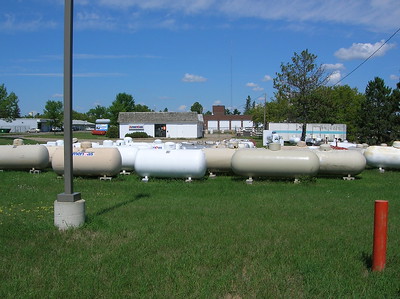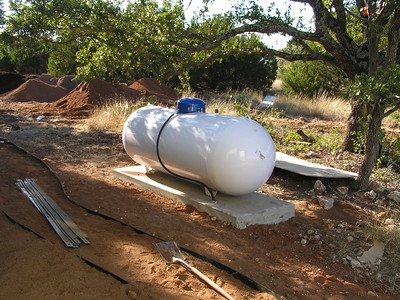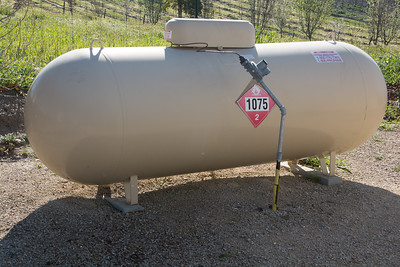
Navigating the California energy market, you may find yourself in need of an efficient, reliable, and cost-effective solution. This is where a 500-gallon propane tank can be the answer to your energy needs.
Not only are propane tanks a dependable power source, but they also offer significant potential for long-term savings. If you’re in the Golden State and searching for a “500-gallon propane tank for sale in California,” you’ve come to the right place.
We’ll delve into the benefits of owning a large-capacity propane tank, provide you with key purchasing considerations, and guide you on where to find the best deals.
Whether you’re in a sprawling city like Los Angeles or tucked away in the Sierra Nevadas, owning a 500-gallon propane tank can be a game-changer. Let’s explore why this fuel solution might be the best fit for your home or business needs.
Read this article: How Much Does 500 Gallon Propane Tank Weigh?
Factors to Consider When Buying a 500-Gallon Propane Tank
Deciding Between Buying New or Used Propane Tanks
When buying a 500-gallon propane tank, one of the first decisions you will need to make is whether to purchase a new or used tank. New tanks come with warranties and meet the latest safety standards, giving you peace of mind. On the other hand, used tanks are generally less expensive but require careful examination to ensure they are in good condition and comply with all safety regulations.
Checking the Condition and Safety Standards of the Tank
Before purchasing a propane tank, it’s crucial to inspect its condition, especially if you’re considering a used tank. Look for signs of wear such as rust, dents, or leaks. Additionally, all propane tanks should adhere to the safety standards set by the National Fire Protection Association (NFPA) and California’s specific state regulations. If you’re unsure, seek advice from a professional.
Understanding the Installation Process
Installation of a 500-gallon propane tank requires careful planning and should always be conducted by licensed professionals. The tank needs a flat, firm surface and must be situated a safe distance from buildings and ignition sources, following local codes and regulations. Be sure to understand the full scope of installation, including necessary preparations and potential costs, before making your purchase.
Environmental and Regulatory Considerations
In this state, environmental regulations are strict, and propane tanks are no exception. Be aware of local and state regulations, including those concerning tank placement, emissions, and regular inspections. Propane is generally considered an environmentally friendly fuel source, but it’s essential to use and maintain it responsibly.
Comparison of Prices from Different Sellers
Price is often a significant factor in any large purchase, and propane tanks are no exception. Prices can vary significantly between different sellers and depend on whether the tank is new or used, the manufacturer, and any additional services offered. Make sure to get quotes from several providers before making your decision. Also, be aware of potential ongoing costs such as delivery, refilling, and maintenance services.
By considering these factors carefully, you can ensure that you’re making the best decision for your energy needs when buying a 500-gallon propane tank.
Read this article: Ways to Hide a 500-Gallon Propane Tank in Your Property
Where to Buy This Size of Tank
There are several places to purchase a 500-gallon propane tank in California, including from a range of online and physical retailers. Each supplier varies in their offerings, delivery options, installation services, and customer service, so it is essential to research and compare to find the best fit for your needs.
Read this article: Where Can You Buy Used 500 Gallon Propane Tank for Sale?
Propane Tank Dealers:
Most cities and towns have local propane tank dealers that carry a variety of sizes, including 500-gallon tanks. These dealers often offer delivery and installation services and can provide valuable local knowledge and advice.
Online Retailers:
There are many online retailers that sell propane tanks. Websites such as Amazon, eBay, and Alibaba offer new and used tanks from a variety of sellers. While you can often find good deals, make sure to check reviews and confirm delivery and installation procedures.
Direct From Manufacturer:
Many propane tank manufacturers sell directly to consumers. These tanks are often brand new and come with manufacturer warranties. Some well-known manufacturers include Manchester Tank & Equipment Co., Worthington Industries, and Highland Tank.
Industrial Supply Stores:
Large-scale industrial supply stores such as Grainger and Northern Tool + Equipment often carry propane tanks and offer online purchasing options.
Agriculture Supply Stores:
Propane is frequently used in agricultural settings, so many agricultural supply stores, like Tractor Supply Co., carry propane tanks.
Energy Companies:
Some energy companies in California also sell propane tanks directly to consumers, particularly those that offer propane delivery services.
Remember, purchasing a propane tank is just one part of the process. You also need to consider installation, which often involves site preparation and meeting safety regulations, and ongoing maintenance. Make sure to ask any potential sellers about these additional services, or consider hiring a professional if they are not provided.
To specify, here are the companies:
- Modern Welding Co. of Kentucky, Inc.
- Suburban Propane
- Ratermann Manufacturing, Inc.
- Roy E. Hanson Jr. Mfg.
- Avcogas Propane Sales & Services
- Trans-Gas Propane
- CT Propane
- Sals Propane Inc.
- Western Energy Propane
- Ted Johnson Propane Co
- AmeriGas Propane
- Globe Propane Inc.
Read this article: Is 500 Gallon Propane Tank The Right Size for Your Home?
Steps to Purchase a 500-Gallon Propane Tank
Navigating the Purchasing Process
- Research: Start by understanding your propane needs, deciding between a new or used tank, and learning about the safety and environmental regulations in your area.
- Find Sellers: Look for reputable propane tank sellers in California, both online and in physical stores. These could be direct manufacturers, online marketplaces, energy companies, or local dealers.
- Compare Offers: Get quotes from multiple sellers. Consider the price, warranty, any additional services, and customer reviews.
- Purchase: Once you’ve made your decision, you can go ahead and purchase your 500-gallon propane tank.
Understanding Delivery and Installation Procedures
- Preparation: Make sure the site is ready for the tank, including a flat, firm surface for it to rest on, and enough clearance from buildings and ignition sources.
- Delivery: Arrange delivery of the tank. Some sellers offer this as part of their service.
- Installation: Installation should be done by a professional to ensure safety and compliance with regulations. This may be offered by your seller or may need to be arranged separately.
Maintenance and Safety Measures Post-Purchase
- Regular Inspections: Tanks should be regularly inspected for leaks, rust, or other signs of wear. Some sellers offer this service, or you may need to hire a professional.
- Refilling: Establish a schedule for refilling your tank based on your usage. This could be part of a delivery service from an energy company.
- Safety Measures: Make sure you understand the safety measures for operating a propane tank, such as keeping the area clear of flammable materials and knowing how to turn off the tank in case of emergencies.
Buying a 500-gallon propane tank is a significant decision, and following these steps can help ensure you make a safe and cost-effective choice that suits your needs.
Will You Buy Above Ground or Underground Propane Tank
When purchasing a 500-gallon propane tank in California, one of the key decisions to make is whether to install the tank above ground or underground. Both options come with unique advantages and considerations.
Above Ground Propane Tanks
Above ground tanks are more common and are often less expensive and easier to install. They’re also easier to access for inspections, maintenance, and refilling. On the downside, above ground tanks can be affected more easily by extreme weather conditions and can be considered an eyesore by some, as they can be quite large and noticeable in your yard.
Underground Propane Tanks
Underground tanks, on the other hand, are hidden from view, which can be a significant advantage if aesthetics or space is a concern. They are also less susceptible to extreme weather conditions. However, the installation process for underground tanks is more complex and costly as it involves excavation. Additionally, special protective measures are taken to prevent corrosion, and an anode bag is installed to protect the tank from electrolysis. Periodic checks of the anode bag is necessary to prevent tank corrosion.
Your choice between an above ground or underground propane tank will depend on factors such as your budget, available space, aesthetic preferences, and willingness to undertake regular maintenance. It’s essential to discuss these considerations with your propane supplier or a professional installer to decide on the best option for your circumstances.
Propane Tank Installation Requirements in California
Installing a propane tank in involves strict adherence to various codes and regulations to ensure safety. These rules encompass tank placement, installation, and post-installation maintenance.
- Tank Placement Requirements:
According to the National Fire Protection Association (NFPA), propane tanks over 125 gallons should be placed at least 10 feet from a building while the 500 gallons should be at least 25 feet away. Tanks with a capacity between 501 and 2000 gallons should be a minimum of 50 feet away from the building and property line. (read here)
Propane tanks should not be installed beneath electric lines, near an ignition source, or in an area with high traffic or prone to flooding.
- Installation Regulations:
All installations must comply with NFPA 58, the Liquefied Petroleum Gas Code, which sets out detailed regulations about the installation of propane tanks.
Propane tank installations must be performed by a certified professional to ensure they meet safety standards. Improper installation can lead to significant safety hazards.
- Post-Installation Maintenance and Inspection:
Regular inspections are required to ensure the propane tank remains in good condition and operates safely. Checks include ensuring the tank is free from leaks or damage, and that all components are working correctly.
Tanks should be kept clear of debris, and vegetation should be kept at a safe distance.
Tanks should be kept painted with a reflective color to prevent excessive heat absorption.
Remember that local ordinances can also impact installation requirements. Always check with your local authorities or a knowledgeable professional to make sure you’re fully compliant with all relevant safety regulations.
How to Save Money When Buying Propane Tank
Purchasing a 500-gallon propane tank is a significant investment, but there are several ways you can save money throughout this process:
- Consider Buying Used: Used propane tanks are often available at a lower price than new ones. However, it’s crucial to thoroughly check the condition of a used tank and ensure it meets all safety standards.
- Compare Prices: Prices can vary significantly between different sellers. Take the time to get quotes from multiple suppliers to ensure you’re getting the best deal. Remember to consider the total cost, including delivery and installation.
- Bundle Services: Some providers may offer a discount if you bundle your propane tank purchase with other services, such as propane delivery or regular maintenance.
- Seasonal Purchasing: Prices for propane tanks can fluctuate throughout the year based on demand. If possible, consider purchasing your tank in the off-peak season when prices may be lower.
- Negotiate: Don’t be afraid to negotiate the price with the seller. If you’ve done your research and can show that you have lower quotes from other providers, they may be willing to offer a discount.
- Energy Efficient Appliances: While this won’t save money on the initial purchase, using energy-efficient appliances can reduce your propane usage and save money in the long term.
- Government Rebates or Incentives: Check if there are any government rebates or incentives available for purchasing propane tanks. Some states offer incentives for using clean energy sources like propane.
Remember, the cheapest option isn’t always the best. It’s crucial to consider other factors such as the tank’s condition, the reputation of the seller, and the cost of ongoing maintenance and refills.
Will You Consider Buying Used Tank
Purchasing a used 500-gallon propane tank is an option worth considering, especially if you’re working with a limited budget. Used tanks can often be found at a significantly lower price than new ones, making them a more affordable choice.
However, there are several factors to keep in mind when considering a used propane tank:
- Condition: It’s crucial to check the tank’s condition thoroughly. Look for signs of wear and tear, such as rust, dents, or leaks. Any damage could pose a safety risk or reduce the tank’s lifespan.
- Safety Compliance: Used tanks should still meet all safety regulations and standards. Ensure the tank has all necessary safety features, such as a working pressure relief valve. You should also check whether it was installed and maintained properly by its previous owner.
- Lifespan: Propane tanks can last for many decades if properly maintained, but their lifespan will depend on factors like the quality of the initial construction and exposure to harsh weather conditions. A used tank may not last as long as a new one, which could affect its value for money.
- Warranty: New propane tanks typically come with a warranty, which offers some protection if there are any issues. Used tanks are less likely to have a warranty, which could mean you’re on your own if anything goes wrong.
- Cost of Repairs: While a used tank may be cheaper upfront, you may end up spending more on repairs or maintenance in the long run. Consider this when weighing up the cost.
In conclusion, buying a used 500-gallon propane tank can be a cost-effective choice, but it’s essential to do your due diligence before making a purchase. It may be beneficial to have a used tank inspected by a professional to ensure it’s safe and a good investment.
In Conclusion
Buying a 500-gallon propane tank in California can be a significant yet rewarding investment. Whether for residential or commercial purposes, propane offers a cost-effective, environmentally friendly, and reliable energy source. The journey to purchasing your propane tank involves a series of crucial decisions, from choosing between new or used, deciding on installation type – above ground or underground, and selecting a reputable supplier.
Remember, when making these decisions, safety should always be the priority. Adherence to regulations and proper installation and maintenance procedures ensure the safe operation of your propane tank. It’s also beneficial to research thoroughly, compare options, and seek professional advice to make the most informed and cost-effective choice.
Whether you reside in bustling cityscapes like Los Angeles or San Francisco, or in quieter corners of the Golden State, a 500-gallon propane tank can efficiently meet your energy needs. So, if you’re in the market for a 500-gallon propane tank, consider the advice outlined in this guide to make the best purchase for your specific circumstances. Here’s to your successful journey towards a more sustainable and efficient energy solution.

Mike is an experienced propane technician with over 15 years of professional experience in the field. He has dedicated his career to helping customers with their propane needs, from installation to maintenance and repair. Together with Jeremy, he co-founded this website to provide useful information and guidance to customers seeking reliable propane services.



